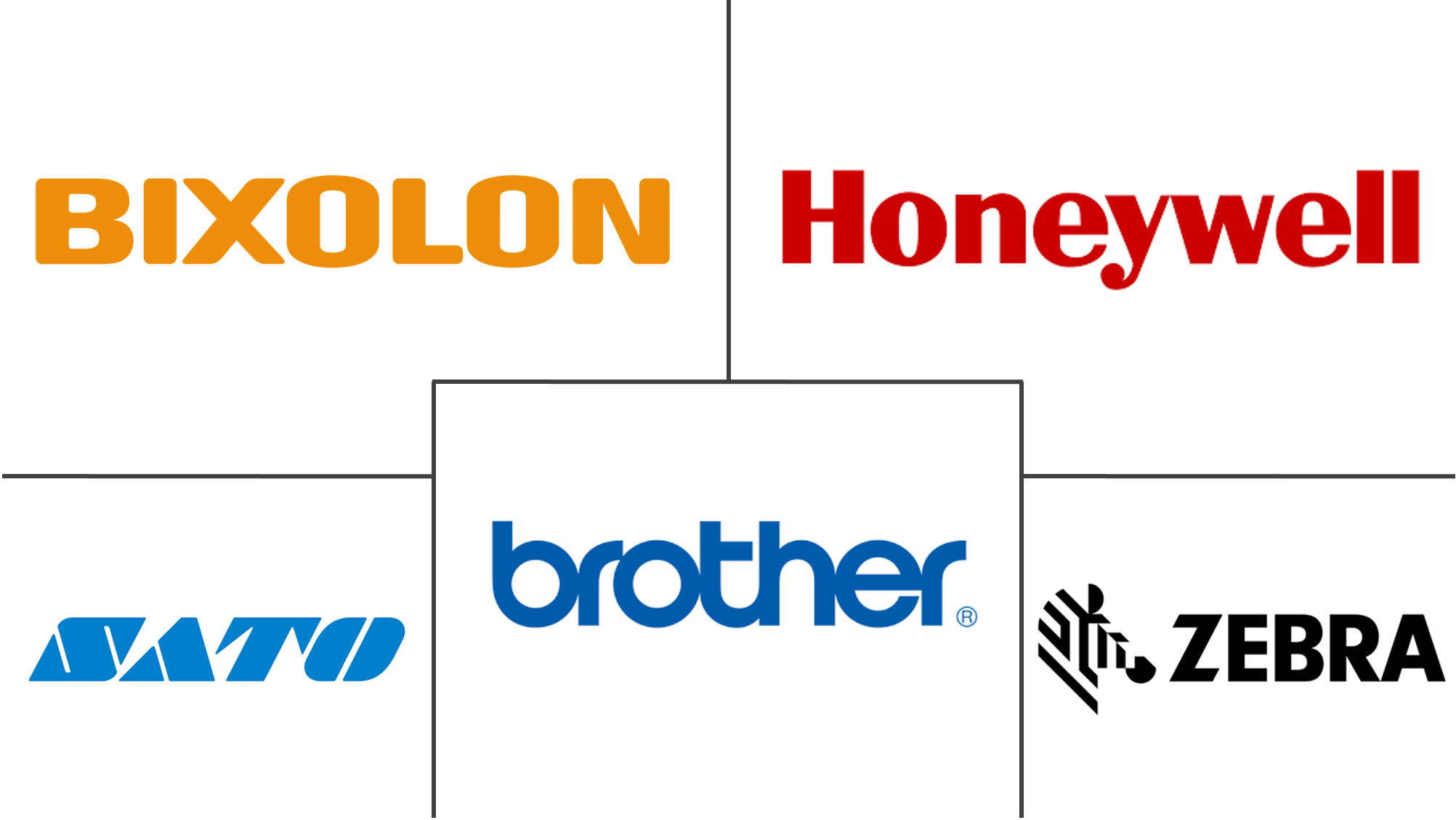Thermal Printing Market Size and Share
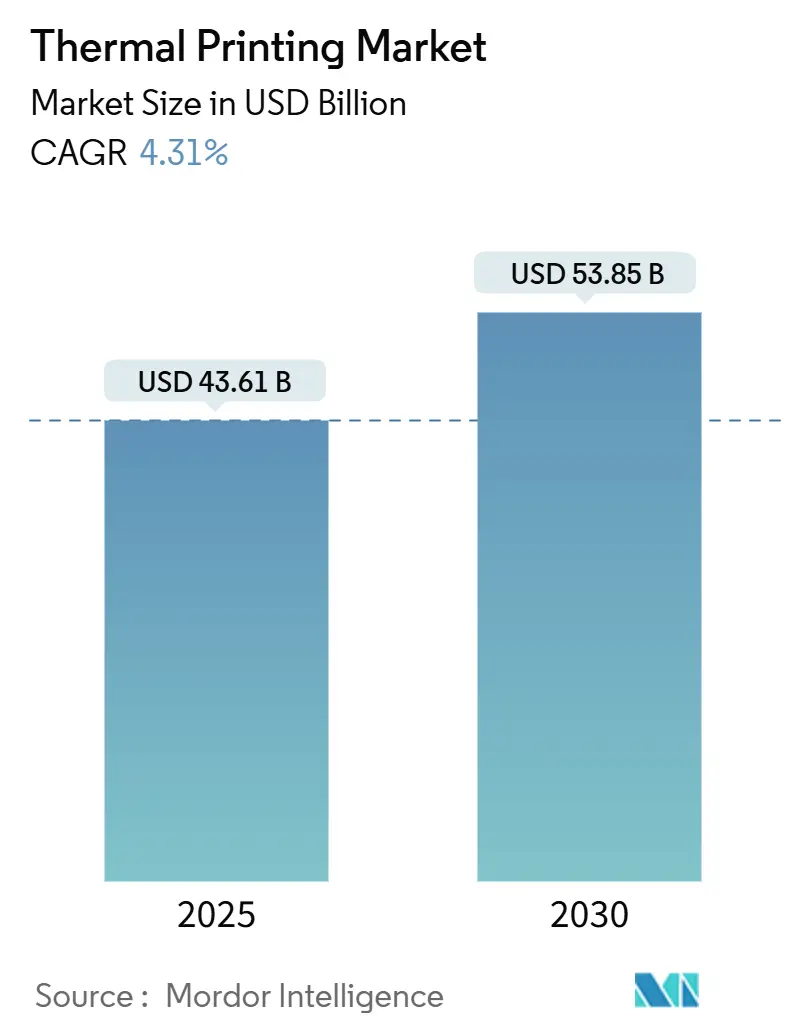
Thermal Printing Market Analysis by Mordor Intelligence
The thermal printing market size is valued at USD 43.61 billion in 2025 and is projected to reach USD 53.85 billion by 2030, translating into a 4.31% CAGR across the period. Sustained momentum comes from healthcare serialization rules, e-commerce parcel volumes, and industrial automation programs that rely on on-demand labels. Regulatory moves banning bisphenol-A and other phenols have triggered accelerated formulation shifts but have not diminished overall print volumes because compliant media options continue to expand. Advancements in IoT-ready printheads, remote fleet management software, and RFID-embedded label workflows strengthen the technology’s relevance inside connected supply chains. Meanwhile, the higher cost of energy and consumables for inkjet or laser systems keeps thermal output attractive for high-volume businesses that ship, stock, or track millions of items annually. Investments by leading vendors in Asia-Pacific factories underline a decisive tilt of global capacity toward the region as multinational customers search for resilient supply networks.
Key Report Takeaways
- By application, barcode printing led with 40.21% revenue share in 2024, while mobile handheld printers recorded the highest projected CAGR at 7.34% through 2030.
- By format type, industrial models held 45.87% of the thermal printing market share in 2024 and mobile formats are forecast to expand at 7.45% CAGR to 2030.
- By printing technology, direct thermal solutions captured 47.54% share in 2024; dye-diffusion thermal transfer is projected to rise at a 5.54% CAGR through 2030.
- By end-use industry, retail and e-commerce accounted for 32.45% of revenue in 2024 and transportation and logistics is forecast to advance at a 5.21% CAGR to 2030.
- By region, North America commanded 35.65% revenue share in 2024, whereas Asia-Pacific is set to grow at 6.25% CAGR to 2030.
Global Thermal Printing Market Trends and Insights
Drivers Impact Analysis
| Driver | (~) % Impact on CAGR Forecast | Geographic Relevance | Impact Timeline |
|---|---|---|---|
| Adoption of AIDC and e-commerce logistics boom | +1.2% | Global, with concentration in North America and Asia-Pacific | Medium term (2-4 years) |
| Expansion of wireless and mobile thermal printers | +0.8% | Global, led by North America and Europe | Short term (≤ 2 years) |
| Cost-advantage over inkjet/laser for high-volume labels | +0.6% | Global, particularly in manufacturing-heavy regions | Long term (≥ 4 years) |
| Growing healthcare compliance labelling needs | +0.9% | North America and Europe, expanding to Asia-Pacific | Medium term (2-4 years) |
| Sustainability push for liner-less and BPA-free media | +0.4% | North America and Europe, with regulatory spillover globally | Long term (≥ 4 years) |
| Cold-chain IoT integration for real-time tracking | +0.3% | Global, with early adoption in developed markets | Long term (≥ 4 years) |
| Source: Mordor Intelligence | |||
Adoption of AIDC and E-commerce Logistics Boom
Parcel operators shifting to two-dimensional barcodes ahead of the 2027 GS1 deadline are refreshing fleets to support higher-resolution QR output, sustaining hardware sales even as label-free returns programs roll out.[1]GS1, “The Transition to QR Codes,” GS1, gs1ie.org Carrier trials show that thermal label volumes spike during peak seasons when order counts climb by 200% and real-time label generation prevents manual bottlenecks. Retailers also deploy cloud-linked mobile printers inside dark stores to print batch pick labels, closing data gaps between online order systems and last-mile couriers. These developments keep the thermal printing market firmly embedded in omnichannel logistics workflows. Finally, logistics hubs integrate print servers with warehouse execution software, allowing automatic printer allocation based on order routes and mitigating downtime risk.
Expansion of Wireless and Mobile Thermal Printers
New Wi-Fi 6–enabled models double data-throughput and reduce roaming drops, giving pickers uninterrupted label access while traveling across yards that span thousands of square meters. Continuous-run batteries now support an entire double shift, cutting mid-day recharge breaks that once halted outbound docks. Linerless capability trims media waste by 50%, pleasing sustainability auditors and raising effective roll capacity. Remote-management dashboards, such as SATO’s Mobile Management System, alert IT teams to low media levels and head temperature anomalies, lowering field visit frequency. Fleet data also feeds predictive analytics models that schedule swap-outs before failures occur, raising overall equipment effectiveness metrics inside distribution centers.
Cost-advantage Over Inkjet/Laser for High-volume Labels
Direct thermal eliminates ink, toner, and drum spend, making it the lowest total cost-of-ownership option for shippers pushing beyond 1,000 labels each day. Energy pull remains modest versus laser rivals because printheads heat only pinpoint dots instead of entire sheets, an advantage that grows as electricity tariffs rise. Thermal transfer ribbons do add consumable expense, yet printhead durability offsets this by stretching maintenance intervals to the 3-million-inch or higher brackets. Recent raw-material hikes, including Hansol’s 10% paper uplift, narrow—but do not void—the differential because ribbon and label suppliers rapidly localize sourcing to avoid currency swings. The emergence of phenol-free topcoats carries a premium, though many brand owners accept higher media cost to sidestep emerging chemical restrictions.
Growing Healthcare Compliance Labelling Needs
Drug Supply Chain Security Act serialization and EU Falsified Medicines Directive both require machine-readable codes at every handoff, keeping printers busy on packaging lines now labeling vials, syringes, and blister cartons.[2]Garcia, “Key Concepts of the FDA’s DSCSA Serialization Laws,” Healthcare Packaging, healthcarepackaging.com Hospitals print patient wristbands that must withstand alcohol wipes and UV germs-killers without image fade, favoring specialized polypropylene stocks delivered via thermal transfer workflows. Cold-chain carriers rely on resin ribbons that remain scannable after −40 °C exposure during anti-viral vaccine distribution.[3]Varcode Editorial, “Regulations and Standards for Pharmaceutical Cold Chain Logistics,” Varcode, varcode.com Clinical-trial managers use temporary thermal labels for kit reconciliation when electronic patient diaries replace paper charts, demonstrating hybrid use rather than outright displacement. Infection-control protocols also accelerate uptake of disinfectant-ready printer housings that survive thousands of bleach wipes.
Restraints Impact Analysis
| Restraint | (~) % Impact on CAGR Forecast | Geographic Relevance | Impact Timeline |
|---|---|---|---|
| High repair and head-replacement costs | -0.7% | Global, particularly in cost-sensitive markets | Medium term (2-4 years) |
| Competition from RFID and digital receipt adoption | -0.9% | North America and Europe, expanding globally | Long term (≥ 4 years) |
| BPA/phenol regulations raising media costs | -0.5% | North America and Europe, with regulatory spillover | Short term (≤ 2 years) |
| Pulp-price volatility disrupting paper supply | -0.4% | Global, with regional variations | Short term (≤ 2 years) |
| Source: Mordor Intelligence | |||
High Repair and Head-replacement Costs
Thermal heads remain the most expensive consumable, often priced at 30% of a new unit, and intensive industrial users still swap them yearly. Complex smart printers embed secure elements and IoT modules that require factory-trained technicians, inflating labor bills. Smaller retailers defer maintenance until failures force emergency purchases, dampening refresh schedules. Vendors answer with harder coatings and quick-swap cassettes that let operators change heads without tools, reducing downtime to minutes. Predictive service algorithms embedded in device firmware also forecast failures before barcode darkness falls below scanner thresholds, though such upgrades increase upfront acquisition prices and may slow adoption in budget-constrained sectors.
Competition from RFID and Digital Receipt Adoption
Tokenized payments now deliver e-receipts directly to consumer wallets, trimming 80 mm POS roll consumption in select pilot stores. Mass-market RFID tags priced below USD 0.03 tempt fashion brands looking for frictionless checkout, threatening some apparel-label volumes. Yet, many regulators still demand paper receipts and the electronics for gate readers drive total cost above simple barcode workflows, keeping RFID confined to high-value merchandise. Printer makers hedge by embedding RFID encoders so converters can print and program tags on one pass, preserving hardware relevance. Hybrid deployments where a QR code and RFID inlay share the same label ensure backward compatibility and slow a swift pivot away from print.
Segment Analysis
By Application: Mobile Solutions Drive Innovation
Barcode printing retained the largest position, accounting for 40.21% of thermal printing market share in 2024 as retailers, manufacturers, and logistics hubs relied on standardized one- and two-dimensional codes to move goods through automated workflows. The segment’s scale is protected by global GS1 alignment, regulatory serialization mandates, and the low cost of consumables, keeping refresh demand stable even as digital transformation shifts some transactions online.
Within the overall thermal printing market size, mobile hand-held printing is projected to expand at a 7.34% CAGR from 2025 to 2030 because warehouse pickers, field technicians, and curbside grocery runners need real-time labels at the item level. Wi-Fi 6 connectivity, longer-life batteries, and linerless media options reduce downtime and waste, encouraging enterprises to replace fixed kiosks with belt-worn units that shorten travel paths and boost task productivity.
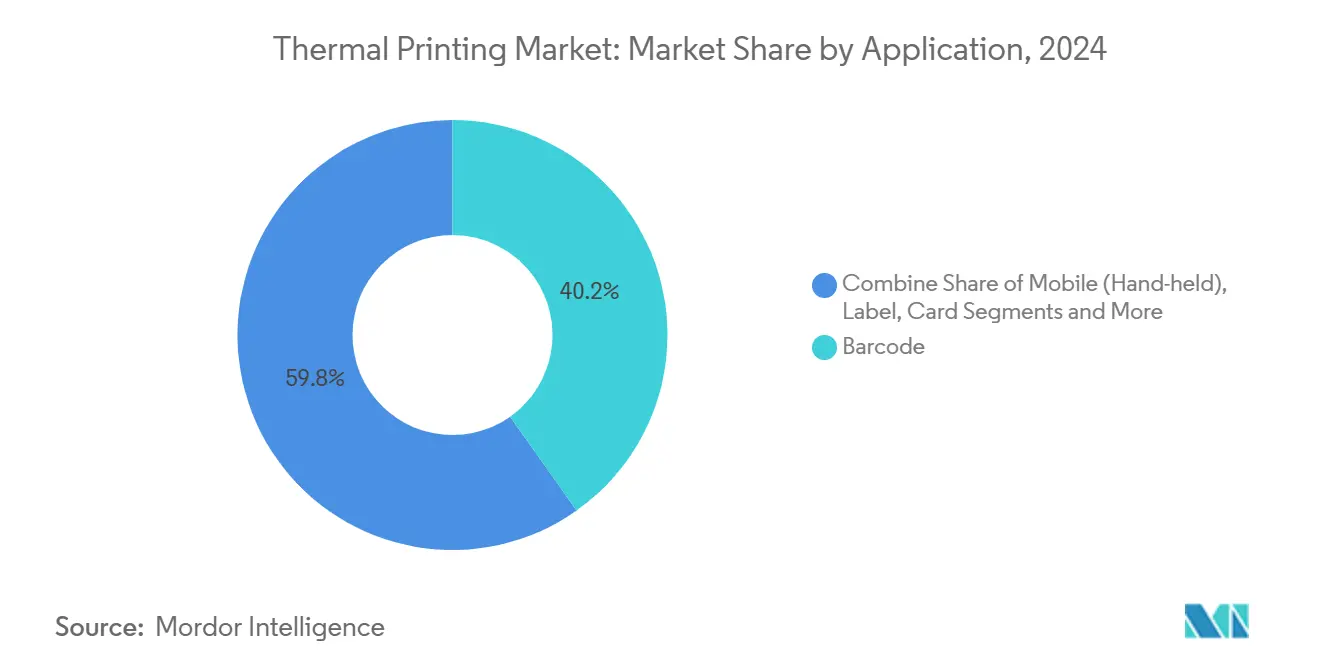
Note: Segment shares of all individual segments available upon report purchase
By Printing Technology: Direct Thermal Dominance Faces Specialized Challenges
Direct thermal claimed 47.54% share in 2024, reinforcing its central place in short-life shipping labels where scannability under 12 months is acceptable. Dye-diffusion thermal transfer, although niche today, posts a 5.54% CAGR through 2030 as healthcare devices and luxury packaging require crisp color gradients and photo-quality graphics.
Direct thermal’s simplicity—no ribbon, fewer moving parts—keeps acquisition and maintenance costs low, supporting high print cycles with minimal oversight. However, images can darken under UV exposure or fade in freezers, limiting usage in outdoor or sub-zero settings. Thermal transfer applies wax, wax-resin, or resin ink to filmic facestocks, achieving scratch and chemical resistance needed in steel stockrooms, electrical labeling, and laboratory vials that undergo autoclave sterilization. Emerging hybrid devices switch between modes via software, allowing warehouses to use economical direct thermal for outbound parcels and rugged resin ribbons for asset tags with 5-year life mandates. Machine-learning-assisted ink laydown tuning, reduces misprints and extends head life.[4]M. Zhou, “Research on Quality Prediction for Thermal Printing Using PSO-BP Neural Network,” MDPI, mdpi.com Meanwhile, research into phenol-free top-coats spurs collaboration between media mills and printer OEMs to calibrate heat profiles that prevent premature head wear. These innovations ensure the thermal printing market maintains breadth across fast-moving consumer goods and mission-critical industrial contexts alike.
By Format Type: Industrial Leadership Meets Mobile Innovation
Industrial segment dominated the thermal printing market size for format types by holding 45.87% revenue in 2024; mobile units, though smaller in base, promise the swiftest growth at 7.45% CAGR to 2030.
Heavy-gauge housings, 600 m ribbon capacity, and large LCD touch panels characterize industrial gear destined for around-the-clock logistics centers. These devices connect to ERP or MES platforms via MQTT or OPC-UA, feeding traceability data straight into corporate data lakes. Desktop units find favor in offices and small batch manufacturing lines, balancing performance and footprint where monthly volumes sit between 5,000 and 30,000 labels. Fast-change platen rollers and auto-calibrate sensors keep downtime minimal even for non-technical staff. Mobility’s lure lies in its ability to print at the point of application—whether affixing a tote ID inside an autonomous vehicle pickup zone or issuing a pharmacy label outside a ward door. The latter saves nurses nearly 40 minutes per shift by removing central print station trips. Organizations increasingly deploy mixed fleets: an industrial machine at the shipping dock, desktops in supervisor booths, and wearables on picking carts. This layered topology fits lean manufacturing philosophies that cut waste steps. Therefore, the format dynamic reflects complementary—not substitutive—roles that jointly enlarge overall thermal printing market opportunity.
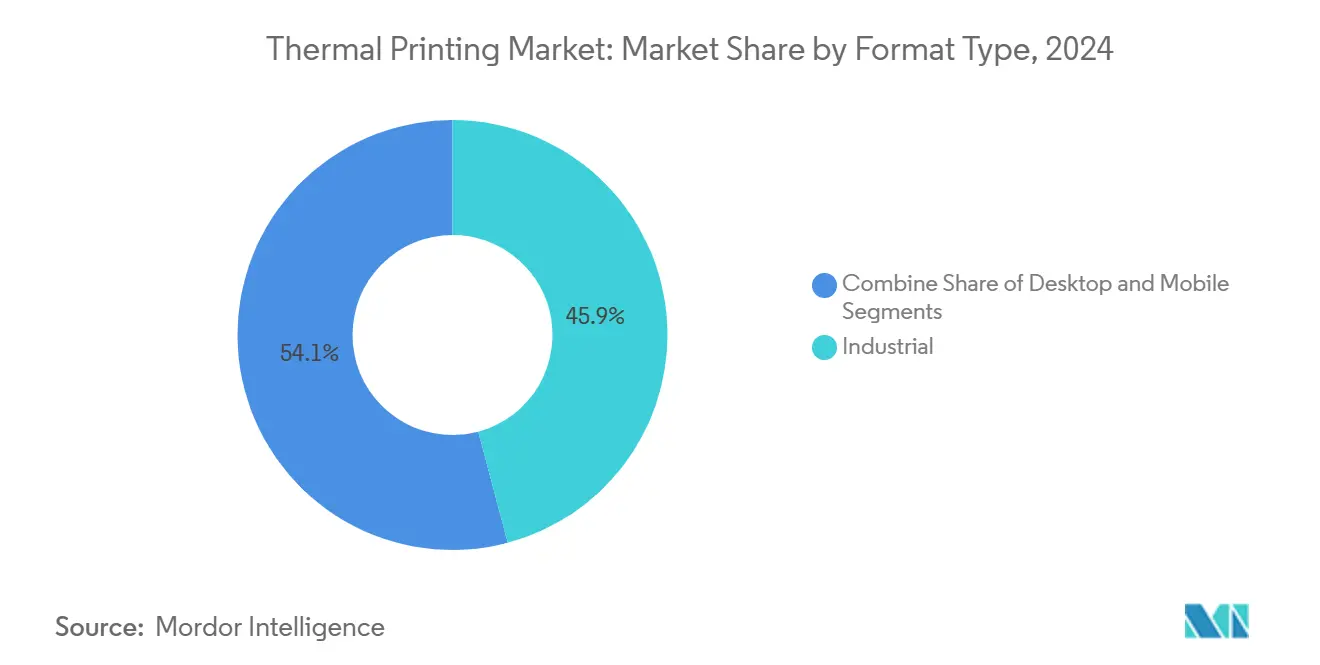
Note: Segment shares of all individual segments available upon report purchase
By End-Use Industry: Healthcare and Logistics Drive Specialized Demand
Retail and e-commerce captured 32.45% of the thermal printing market size in 2024 as omnichannel brands prioritized accurate last-mile labelling. Transportation and logistics, however, is projected to log a 5.21% CAGR through 2030, making it the fastest mover among verticals.
Same-day delivery guarantees elevate label accuracy because a mis-sort compels expensive redelivery attempts. Carriers therefore embed AI vision checks inline to verify barcode readability immediately after print, rejecting illegible items before they leave sortation belts. Manufacturing plants printing compliance plates add QR codes that link to digital manuals, improving serviceability and reducing paper inserts. Pharmaceutical packers, driven by DSCSA serialization checkpoints, now print variable-data codes at 300 items per minute while cameras validate human-readable content corresponds to embedded EPC data. Government agencies require tamper-evident thermal laminates for secure document issuance, sustaining a robust though niche demand pool. Banking uses receipt printers for branch compliance, yet is slowly pivoting to customer-option email proofs, extending hardware refresh cycles but not eliminating the installed base. Across all segments, sustainability scorecards pressure companies to adopt linerless workflows and curb media waste, a trend fueling R&D into low-adhesion release coatings compatible with existing printheads.
Geography Analysis
North America accounted for 35.65% of revenue in 2024 thanks to strict healthcare regulations, extensive warehouse automation, and high adoption of data-rich QR and RFID labelling. Federal traceability mandates ensure hospitals and pharmaceutical firms refresh printers as soon as standards evolve, and multi-site retailers standardize on enterprise-class management suites that optimize fleets across hundreds of stores. E-commerce volumes remain elevated post-pandemic, keeping parcel hubs focussed on rugged high-throughput units.
Europe follows with a sizable share, underpinned by eco-design regulations and consumer pushback against phenols, propelling R&D investments in bisphenol-free media. The region champions linerless adoption to satisfy waste-reduction directives and carbon-footprint goals. Manufacturers in Germany and the Nordic countries integrate printers with Industry 4.0 stacks, using OPC-UA gateways to feed label data directly into digital twins for batch genealogy. Real-time monitoring of printhead health aligns with predictive maintenance strategies prevalent in the region’s smart factories.
Asia-Pacific is the fastest-growing slice, forecast at a 6.25% CAGR, as Chinese, Indian, and ASEAN logistics carriers build dense last-mile networks that require on-the-spot label generation. Investments like Epson’s Akita printhead plant, tripling capacity, indicate upstream component consolidation in Japan serving rising regional demand. Domestic printer brands leverage lower labor costs to capture price-sensitive SMEs, while multinational 3PLs import enterprise-grade devices to satisfy global customer SLAs. Government projects such as India’s Unified Logistics Interface Platform (ULIP) encourage barcode standardization across ports and railroads, further widening the addressable base. Middle East and Africa and South America trail in scale but register steady expansion as retail modernizes and public safety digitizes asset tracking; currency volatility, however, slows refresh cadence, prompting vendors to offer subscription models that spread capex over multi-year contracts.
Competitive Landscape
Vendor concentration remains moderate because large installed bases and proprietary management suites make customers reluctant to switch. Zebra Technologies, SATO Holdings, and Honeywell International defend share through broad partner programs and print DNA–style firmware that embeds security and analytics features customers cannot easily replace. Xerox’s pending USD 1.5 billion Lexmark acquisition signals convergence between office and industrial print portfolios, aiming to cross-sell workflow software and achieve USD 200 million in cost synergies. Epson’s USD 591.4 million purchase of Fiery accelerates entry into high-color industrial packaging, complementing its core monochrome receipt range.
Asian challengers, notably TSC, Bixolon, and Xprinter, exploit local manufacturing cost advantages to win tenders in price-driven markets, especially among small logistics firms spinning up fulfilment nodes nationwide. To defend margins, incumbents emphasize total cost-of-ownership arguments, highlighting head durability, energy savings, and superior remote-service infrastructure. Sustainability has emerged as an important differentiator: SATO’s refreshed CL4NX Plus packaging slices CO₂ emissions by 39% across the box lifecycle, an advantage during bids with ESG scoring components.
Software ecosystems increasingly dictate hardware choice. Cloud APIs that expose printer status, job queues, and security logs let DevOps teams fold labelling into CI/CD-style architectures. Vendors bundle low-code connectors to SAP, Oracle, and Microsoft Dynamics, easing deployment friction. As asset visibility platforms pivot to edge AI, partnerships between printer OEMs and machine-vision firms bring label validation cameras under a single pane of glass. Meanwhile, IP litigation around printhead coatings and energy-efficient dot heaters intensifies as companies race to extend duty cycles. Overall, the competitive theatre balances innovation, cost pressure, and sustainability, ensuring the thermal printing market continues evolving rather than ossifying.
Thermal Printing Industry Leaders
-
Zebra Technologies Corporation
-
Sato Holdings Corporation
-
Honeywell International Inc.
-
Bioxolon
-
Brother International Corporation
- *Disclaimer: Major Players sorted in no particular order
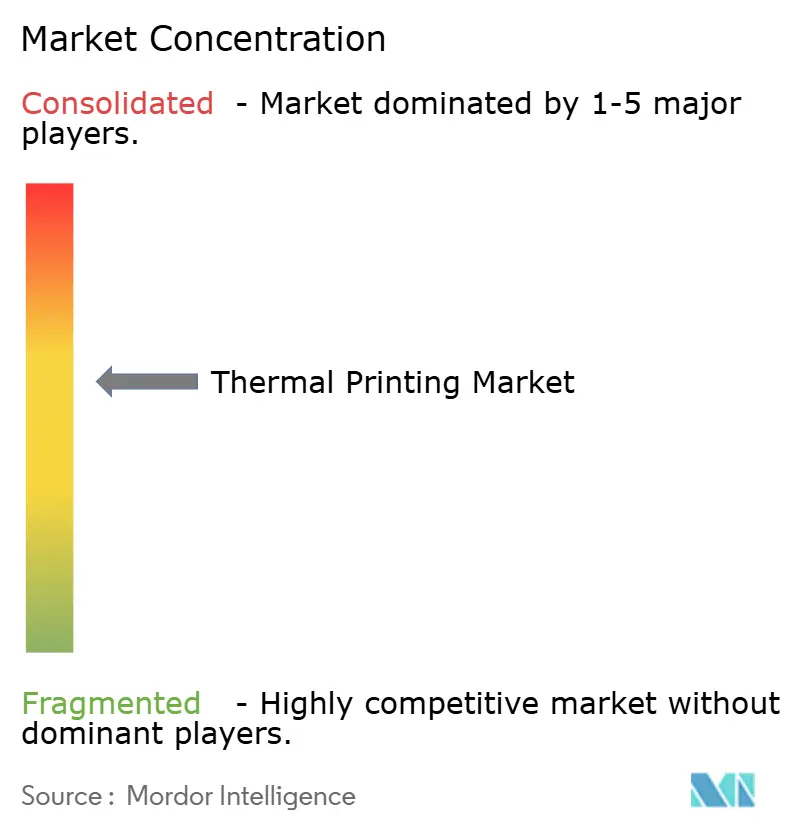
Recent Industry Developments
- April 2025: Hansol announced a 10% price increase on thermal paper citing raw-material inflation.
- February 2025: SATO completed its purchase of Checkpoint Systems’ Barcode Systems (BCS) Group, more than doubling its overseas barcode-printer revenue base and extending manufacturing and sales operations across North America, Europe, Australia, and New Zealand.
- December 2024: Xerox agreed to acquire Lexmark International for USD 1.5 billion, a deal expected to close in H2 2025.
- September 2024: Epson completed its USD 591.4 million acquisition of Fiery, expanding digital print capabilities.
Research Methodology Framework and Report Scope
Market Definitions and Key Coverage
Our study defines the thermal printing market as global revenue generated from the sale of new direct-thermal, thermal-transfer, and dye-diffusion printers, industrial, desktop, and mobile formats, and the associated OEM supplies (ribbons and coated media) that drive recurring spend across retail, logistics, healthcare, manufacturing, banking, and government workflows.
Scope exclusion: finished labels produced by converters and aftermarket refurbished printers are outside our sizing.
Segmentation Overview
- By Application
- Barcode
- POS / Receipt
- Label
- Card
- RFID
- Kiosk and Ticket
- Mobile (hand-held)
- By Printing Technology
- Direct Thermal (DT)
- Thermal Transfer (TT)
- Dye Diffusion Thermal Transfer (D2T2)
- By Format Type
- Industrial
- Desktop
- Mobile
- By End-Use Industry
- Retail and E-commerce
- Transportation and Logistics
- Manufacturing and Warehouse
- Healthcare and Pharma
- Government and Public Safety
- Hospitality and Entertainment
- Banking and Financial Services
- Geography
- North America
- United States
- Canada
- Mexico
- Europe
- Germany
- United Kingdom
- France
- Italy
- Spain
- Russia
- Rest of Europe
- Asia-Pacific
- China
- Japan
- India
- South Korea
- ASEAN
- Rest of Asia-Pacific
- Middle East and Africa
- Middle East
- Saudi Arabia
- United Arab Emirates
- Turkey
- Rest of Middle East
- Africa
- South Africa
- Nigeria
- Rest of Africa
- Middle East
- South America
- Brazil
- Argentina
- Rest of South America
- North America
Detailed Research Methodology and Data Validation
Primary Research
We interviewed printer-OEM product managers, label converters, 3PL warehouse IT heads, and hospital materials directors across North America, Europe, China, India, and Brazil. Their inputs on average print-engine lifecycles, media run-rates, and project pipelines helped validate model assumptions and refine regional growth multipliers.
Desk Research
Mordor analysts first map demand fundamentals using open datasets such as UN Comtrade codes 844332 and 482110 for printer and thermal-paper trade, US Census Bureau quarterly e-commerce sales, Eurostat retail turnover, and International Air Transport Association parcel-weight statistics. Regulations from the FDA's UDI database and EU MDR, plus patent activity pulled through Questel, clarify compliance-led adoption cycles. Company 10-Ks, investor decks, and Dow Jones Factiva news feeds enrich volume and ASP signals. (The sources named illustrate, not exhaust, the wider desk work undertaken.)
Market-Sizing & Forecasting
A top-down build starts with 2024 installed-base figures and trade-reconstructed shipment totals, which are then paired with median replacement cycles and media consumption elasticities to derive 2025 spend. Select bottom-up cross-checks, sampled vendor revenue splits, and channel ASP times unit estimates anchor totals within ±4 percent of management-guided ranges. Key variables include barcode-printer shipments, mobile-printer penetration in retail POS lanes, e-commerce parcel growth, thermal-paper price index, and healthcare wristband utilization. Multivariate regression links these drivers to historical revenue, while scenario analysis layers in BPA-free media cost swings and regional logistics capacity shifts for 2026-2030 projections. Data gaps in emerging regions are bridged by calibrated ratios to comparable GDP-per-parcel clusters.
Data Validation & Update Cycle
Outputs undergo variance screens versus independent indicators; anomalies trigger re-contacts with sources before sign-off. Reports refresh annually, with interim updates issued when currency swings, component shortages, or major M&A alter baselines.
Credibility Anchor: Why Mordor's Thermal Printing Baseline Commands Reliability
Published estimates differ because firms choose dissimilar printer-type mixes, bundle or exclude supplies, convert currencies on different dates, and apply varied refresh cadences.
Key gap drivers typically stem from counting refurbished units, assuming uniform ASP erosion, or rolling forward pre-pandemic growth curves without cross-checking parcel data spikes. Mordor's model, in contrast, locks scope to new-build hardware plus OEM supplies only, refreshes exchange rates quarterly, and weights forecasts with live primary feedback.
Benchmark comparison
| Market Size | Anonymized source | Primary gap driver |
|---|---|---|
| USD 43.61 Bn (2025) | Mordor Intelligence | - |
| USD 53.50 Bn (2025) | Global Consultancy A | Includes refurbished hardware and service contracts, uses calendar-year average FX |
| USD 49.30 Bn (2024) | Industry Journal B | Earlier base year rolled forward without adjusting for 2025 inflation and freight cost softening |
As the table shows, values diverge once scope breadth, base year, and cost assumptions shift. Because Mordor Intelligence ties every figure to traceable trade lines, live industry interviews, and yearly currency resets, decision-makers gain a balanced, reproducible baseline they can trust for budgeting and strategy moves.
Key Questions Answered in the Report
What is the current valuation of the thermal printing market?
The thermal printing market stands at USD 43.61 billion in 2025 and is forecast to reach USD 53.85 billion by 2030 with a 4.31% CAGR.
Which application segment leads in revenue share?
Barcode printing holds the top position with 40.21% share of 2024 revenue.
Why are mobile thermal printers growing faster than other formats?
Workforce mobility and real-time labelling in logistics and field service drive a 7.45% CAGR for mobile units through 2030.
Which region is expanding the fastest?
Asia-Pacific shows the highest growth trajectory at 6.25% CAGR, fuelled by manufacturing expansion and e-commerce scaling.
How do bisphenol-free mandates affect total cost of ownership?
Phenol-free media carries a premium, but compliance, sustainability credentials, and stable ribbon pricing largely preserve thermal’s cost advantage over inkjet or laser alternatives.
What technological shift is most impacting direct thermal dominance?
Demand for durable, high-color labels in healthcare and premium retail is accelerating adoption of dye-diffusion thermal transfer units with a 5.54% CAGR outlook.
Page last updated on:
